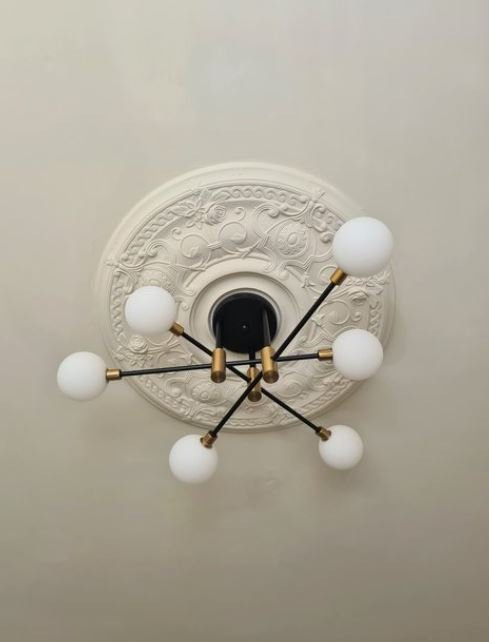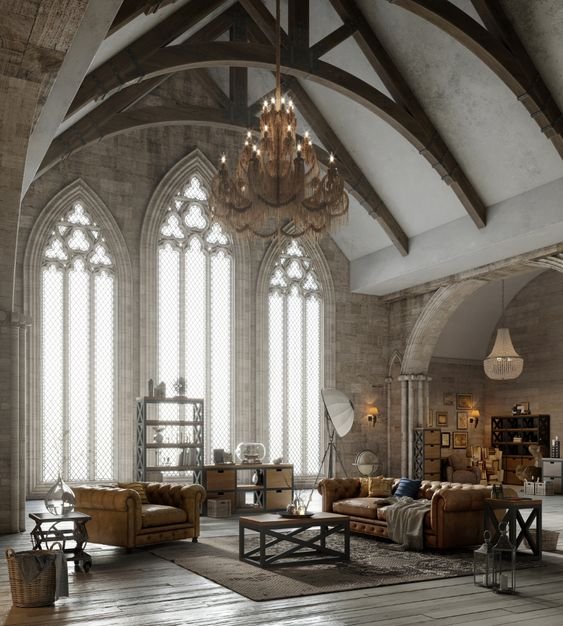History of Ceiling Roses Through The Ages
The original use for ceiling roses in period homes across the UK was to protect the ceiling from damage from the gas lights in the home. From their humble beginnings to their modern-day resurgence, these ornate motifs have played a crucial role in adding character and charm to period homes across the nation. When renovating a period home it is important to understand if the architectural features are traditional or if they have been added through time, understanding the motifs that defined each era will help define which of the features in your home are original.
By the way, if you’re new here, I’m Jessica, Interior Designer who specialises in helping period homeowners harmonise contemporary living and period homes.
You can trace the first ceiling roses as we know them today back to the Georgian era (1714-1830), characterised by ornate and extremely intricate designs, the early Georgian roses featured classical motifs such as acanthus leaves, rosettes, and Greek key patterns. These designs aimed to emulate the elegance of ancient Roman and Greek architecture, reflecting the neoclassical movement prevalent during this period.
Image Credit: Georgian Motifs
Image Credit: Home Designing
Neo-Classic Inspired Interiors
The Victorian era, known for its opulence saw the rise of even more elaborate ceiling roses, they were larger with floral motifs, such as roses, lilies, and intricate leaf patterns. Additionally, symbolic elements like shells, scrolls, and intricate geometric patterns adorned the roses, often reflecting the era’s fascination with nature and the Gothic Revival movement. Dining rooms and parlours in a period home were the prime locations for these impressive embellishments, creating a sense of luxury and sophistication for social gatherings this was key to demonstrating wealth which was incredibly important to the high society in Victorian England. In comparison the cornice and ceiling roses would have been much more paired down in the areas of the house that weren’t used for social engagements.
Image Credit: Studio Smith Interiors
Image Credit: Behance.Net
As the Victorian era gave way to the Edwardian period, a shift towards lighter and more delicate motifs became apparent, ceiling roses during this time often featured geometric patterns and stylised floral designs, adding a touch of elegance to the bedrooms and sitting rooms of a period home, aiming for a softer and more relaxed atmosphere.
Image Credit: Etons of Bath
As the 19th century transitioned into the 20th century, design trends shifted again. The Art Nouveau movement (late 19th to early 20th century) introduced flowing, organic motifs inspired by nature. Floral designs, sinuous lines, and motifs depicting natural forms like vines, flowers, and insects emerged in ceiling roses, reflecting the artistic rebellion against the strict geometries of the past.
The roaring twenties brought about the Art Deco movement, and ceiling roses took on a new, bold identity. Designs from this era embraced symmetry, bold clean lines and geometric shapes. Popular in reception rooms and hallways of a period homes, Art Deco ceiling roses added a touch of glamour and modernity, reflecting the spirit of the times.
After the austerity of World War II, a shift towards simplicity and functionality emerged in design, ceiling roses during the post-war period became more understated featuring clean lines and simple floral motifs, being flashy and demonstrating your wealth wasn’t the done thing in post-war England.
In more modern times there has been a real drive to reinstate architectural features that have been stripped from homes throughout the 70’s and 80’s and the use of ceiling roses are much more prevalent in modern interior design. To the extent that a new interior design style is being coined modern Victorian to describe how people are decorating their homes, it essentially embodies the idea of blending the old and the new. Embracing the idea of adding texture and visual interest to their home design. Contemporary motifs range from minimalist and abstract designs to nods to historical periods and with today' homes, ceiling roses have found a place in various rooms, transcending their historical limitations and all rooms are now to benefit from the visual impact of these decorative elements.
Image Credit: Farrow and Ball
In Modern Victorian we are even painting differently, traditionally the architectural features such as ceiling roses, cornice etc, would have been left white, they were designing to be a focal point of the space, designed to demonstrate wealth after all. There has been a shift in recent years, gone and the days of leaving them white, we are experimenting with all sorts of options and I love this approach, it is about asking what the space needs and painting to enhance the room, it really adds wonderful texture and doesn’t make the room only about the architectural details, but you don’t miss them - the visual interest is still there.
Image Credit: Bradley
VanDerStraeten
I understand period features are tricky to pin down, it is important that we are enhancing those traditional features and preserving a little bit of history along the way. I would absolutely love to help, explore my services here.
Jessica








